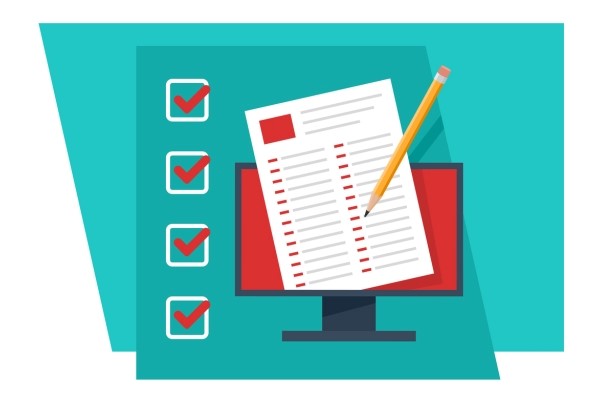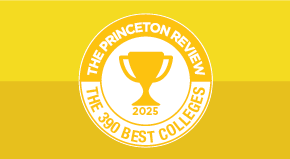
If you’re looking to get a good score , there’s more to SAT testing than just showing up on the day of the exam. You’ll want to familiarize yourself with the format (like the built-in calculator) and content (like the grammatical rules and mathematical formulas). It’s a good idea to take at least one practice test (hopefully more!) that gets you used to its timing. Here’s everything else you should get ready (and be ready for) on and around test day.
What To Do the Week Before
- Download Bluebook. If you plan to bring your own device, make sure it has the Bluebook app. This means you’ll want to download, install, and open it, registering or linking your account. (Even if you used it for your PSAT, you’ll still want to check that everything’s up-to-date.)
- Verify your admission ticket. When you’re 5 days from the test date, you can find this in Bluebook. It’s a good idea to print a physical copy as well as to email it to yourself.
- Map out how to get to the testing center. If you’re not sure how to get there, take a practice run.
- Check the College Board website. Don’t wait until the last minute to find out that you’ve brought an invalid electronic device, form of ID, and/or calculator.
What To Do the Night Before
- Pack your bag. See the list below for what to bring and not bring. It’s also a good idea to lay out your outfit and do as much as you can the night before so that you can have a relaxing morning with everything ready to go.
- Charge your device. Don’t count on having a power outlet near your seat.
What to Bring
- Your charged device. If you plan to use your own laptop or tablet , check the College Board website to ensure that your device is approved. Setting up Bluebook will also give you confirmation that your device is allowed.
- Your charger. Although there’s no guarantee you’ll have access to an outlet, it’s a good idea to bring a charger in case you do.
- A photo ID. This can be a driver’s license, school ID, or passport. See the College Board website for more information on what forms of ID are acceptable.
- Your admission ticket. This can be printed out on paper or displayed on a phone. (Just remember to power off and store your phone after checking in.)
- Pens and/or pencils. Scratch paper is provided, but you’ll need to bring your own writing implements. You won’t be filling out a bubble sheet, so pens and/or pencils (including mechanical ones) are fine.
- A drink and snack for the break. Something like a water bottle and a granola bar works great.
Optional Extras
- Your handheld calculator. A built-in graphing calculator is provided, but you may find it more convenient to use a handheld calculator for some operations. Graphing calculators are generally permitted, but check the College Board website, as some types are prohibited.
- A watch. This may be helpful for keeping track of time during the break so that you don’t come back late. Smartwatches and watches with alarms are not allowed.
- A mask and hand sanitizer. These hygiene items are permitted during the test.
- A bag or backpack. This is a good place to carry and store your belongings for easy transport.
- An external keyboard (tablets only) and/or external mouse (tablets and laptops). If you normally use your device with permitted external inputs, don’t suddenly try to go without them on test day.
- Backup device. If you have a second approved device, it’s permitted to bring that device as a backup.
Don’t Even Try It
- Your phone . You can use your phone to check in, but there are serious consequences if anyone sees or hears your phone once the test begins (the test could be canceled for you and those sitting around you). It’s best to leave your phone at home or in the car if at all possible.
- Headphones, earplugs, Bluetooth devices, smartwatches, etc. Don’t bring any electronic devices beyond what you’ll be testing on, and perhaps a permitted backup device.
- Highlighters, colored pencils, rulers, scissors, books, or paper. Stick to pens and/or pencils.
What To Do the Morning of the Test
- Wake up early. Give yourself plenty of time to get ready.
- Exercise and/or take a shower. You want to feel fully awake and energized to take the test.
- Eat breakfast. Aim for something nutritious that will keep you full for several hours.
- Leave with plenty of time to get to the testing center. The testing center can’t do anything for you if you get delayed by traffic.
What to Expect from the SAT Testing Experience
- The proctor. Your room will be monitored by an adult called a proctor. The proctor is in charge of reading the directions, making sure all rules are followed, and providing scratch paper. The strictness of the proctor will vary, and they don’t always know a lot about the test. Make sure you know the policies yourself.
- Starting the test. The proctor will give everyone a code, and then the tests will start on everyone’s devices.
- The break. You’ll get a 10-minute break between Reading and Writing (RW) and Math. Use that time to go to the bathroom if needed, have your snack and drink, and give your brain a break. Leave your device open and your calculator on your desk, and bring your ID, as it may be checked when you come back.
- Testing irregularities. If anything external happens that severely affects your ability to take the test, inform the proctor before you leave the testing center.
Now you know what you need for when it’s SAT testing time. If you’re also comfortable with the Digital SAT’s content, you’ll be in great shape for test day!
Explore Colleges For You
Connect with our featured colleges to find schools that both match your interests and are looking for students like you.
Get Started on Athletic Scholarships & Recruiting!
Join athletes who were discovered, recruited & often received scholarships after connecting with NCSA's 42,000 strong network of coaches.
Best 390 Colleges
168,000 students rate everything from their professors to their campus social scene.
Explore Colleges For You
Connect with our featured colleges to find schools that both match your interests and are looking for students like you.
Get Started on Athletic Scholarships & Recruiting!
Join athletes who were discovered, recruited & often received scholarships after connecting with NCSA's 42,000 strong network of coaches.
Best 390 Colleges
168,000 students rate everything from their professors to their campus social scene.
Explore Colleges For You
Connect with our featured colleges to find schools that both match your interests and are looking for students like you.
Get Started on Athletic Scholarships & Recruiting!
Join athletes who were discovered, recruited & often received scholarships after connecting with NCSA's 42,000 strong network of coaches.
Best 390 Colleges
168,000 students rate everything from their professors to their campus social scene.



